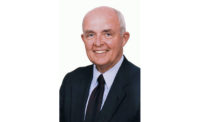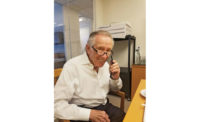Alaska has more than its share of airstrips, and ENR Northwest’s 2017 Legacy Award winner Earl Korynta worked on almost all 250 of them, directly or indirectly.
The North Dakota native developed a love of engineering after reading the Encyclopedia Britannica in his one-room schoolhouse and calculating the height of cottonwood trees by extrapolating from the length of their shadows. Korynta went on to earn engineering degrees at the University of North Dakota and the University of Alaska Anchorage. In 1965, after responding to an ad in ENR, Korynta was offered a job with Alaska’s Dept. of Public Works and worked in the state for almost 50 years.
His career includes work as senior engineer in 2008 on the Ted Stevens Anchorage International Airport Taxiway K reconstruction, the longest taxiway in Alaska at more than three miles. Korynta also served as project manager in 2006 on the Alaska CargoPort, the second-busiest cargo airport in the U.S. In 2015, he was senior engineer on a Juneau International Airport runway rehabilitation project that was accelerated due to Federal Aviation Administration concerns about runway conditions. In addition, Korynta worked as senior engineer on the Lake Hood bank project that stabilized one of the most active seaplane bases in the world.
As a private pilot with thousands of hours of flying experience, Korynta describes himself as both a designer and a user of airfields. “My love of flying keeps me going,” he says.
The legacy award winner did not exclusively work on aviation projects, however. He has worked on anything and everything, says Zane Shanklin, a Stantec principal and civil engineering manager who worked with Korynta in the early 1990s. One time Korynta was looking at a request for proposal that the state of Alaska had taken 15 years to develop. With a piece of paper and colored pencil, Korynta scratched out why it wouldn’t work and the state agreed. His team was later chosen to fix the plan.
“He bridges the gap between planner and engineer,” Shanklin says. “He sees the big picture and all the impacts a project will have.”
In 1972, Korynta and three friends, Gordon Unwin, Leo von Scheben and later architect Jim Huettl, founded what became USKH Inc. They grew it into a 130-person, multidisciplinary firm—one of the largest in Alaska. Stantec acquired USKH in 2014.
“We were grinders,” Korynta recalls. “We took on anything and everything and just ground it out.”
The first big project was for the Army Corps of Engineers. “That was when we knew we were going to make it; we had a federal contract,” he says.
Claude Vining, retired engineering division chief from the U.S. Army Corps of Engineers, recalls breaking new ground with the USKH team just when extraordinary measures were most needed. The district was maxed out on projects and office space and received approval to try a new type of professional contracting—open-end contracts. They negotiated such a contract with USKH.
“What a great way to basically increase staff, monitor the work and reduce our overhead,” Vining says. “USKH continued to expand and produce quality work. They were (and still are) a highly respected organization. Each one of the original cadre is esteemed. They made working together not only profitable, but enjoyable.”
In addition to work at Eielson Air Force Base Physical Fitness Center, Korynta was also lead engineer for the Port of Anchorage Infrastructure Expansion, which required designing 12,000 linear ft of new railroad spur line, eight acres of paved freight handling yard and more than 250,000 cu yd of excavation and backfill. He served as lead civil engineer for the design-build Bear Paw Family Housing Development project, a neighborhood of 75 houses at Fort Wainwright, Alaska.
Named the Alaska Engineer of the Year in 1980, Korynta was a founding member and the first president of the Alaska Professional Design Council. He is also a past president of the American Society of Civil Engineers-Alaska Section and a member of the National Society of Professional Engineers and the American Society for Testing and Materials.
Korynta retired in 2014 but is still a regular part of the Stantec aviation team, frequently poring over drawings with “a red pencil in hand,” says Shanklin.
“The opportunities in engineering and in Alaska are so vast today. There is still so much more to do,” Korynta says.







Post a comment to this article
Report Abusive Comment